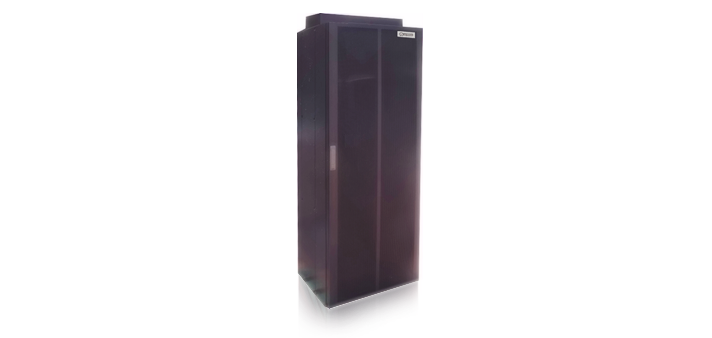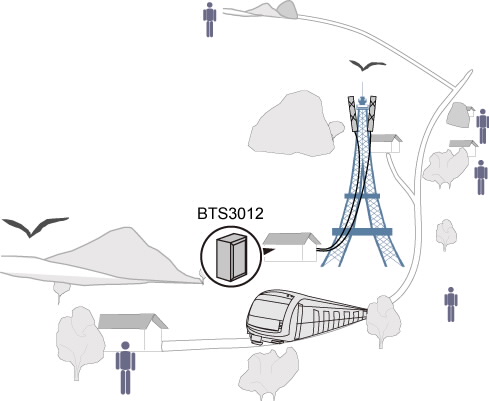BTS3012
The Huawei BTS3012 is a type of indoor macro base station. It features high integration and excellent performance, thus meeting the requirements for the long-distance coverage of the GSM-R network along railways.When applied in the GSM-R network, the BTS3012 uses the double-transceiver units (DTRU). A BTS3012 cabinet supports a maximum of 12 TRXs.

High Reliability
Huawei BTS3012 is capable of operating with two reliability-enhancing features that are of particular interest for GSM-R networks:
- The BTS3012 supports the "single frequency double coverage" feature
The single frequency double coverage scheme enables two BTSs working in active/standby mode to cover the same area. In addition, only one of the BTSs is working at any specific time. The two BTSs use exactly the same frequencies. In normal cases, the active BTS works properly, whereas the standby BTS works but does not transmit power. When the active BTS is faulty, the BSC triggers the switchover between the active BTS and the standby BTS. Specifically, the previously active BTS is downgraded to "standby BTS" status, whereas the previously standby BTS is upgraded to "active BTS" status. This redundant coverage does not require any additional frequencies compared to single coverage, thus improving network availability and ensuring continued network operation even in the case of a BTS failure. - The BTS3012 supports the "single frequency TRX redundancy" feature
The single frequency TRX redundancy feature enables a BTS to be configured with a standby TRX that shares the same frequencies with an active TRX. When the active TRX is faulty, the standby TRX is automatically activated to take over, thus improving network availability and ensuring continued network operation even in the case of a BTS failure. - High receive sensitivity
- The static sensitivity of the TCH/FS channel is –112.5 dBm (a typical value in normal temperature)
- Power boost technology (PBT)
- The maximum transmit power of the DTRU can reach 100 W.
- Transmit diversity and 4-way receive diversity
- Supports multiple transmission modes such as E1, T1, and STM-1 transmission.
- Supports multiple topologies such as star, tree, chain, ring, and hybrid topologies.
- Supports automatic fast switching to the backup route in ring topologies, without any interruption of ongoing services.
- Supports Remote Electric Tilt (RET) antennas.
- Supports dual polarization antennas. This reduces the number of antennas in a cell.
- The BTS3012 supports installation against the wall.
- The external cables come into the BTS through the top of the cabinet.
- All the cables are accessible from the front of the cabinet.
- The field installation personnel only need to position the cabinet, insert the boards, install the external cables, and download the data configuration files.
Coverage Capability
The BTS3012 has the following benefits in terms of coverage:
Networking Capability
The BTS3012 has the following benefits in terms of networking capability:
Antenna
The BTS3012 has the following benefits in terms of antenna:
Installation
The installation of the BTS3012 has the following features:
The simple and fast installation of the BTS3012 software and hardware helps to minimize the delay to install and deploy a network.
Working Frequency Bands
Table 4-1 lists the working frequency bands of the BTS3012. The space between carriers is 200 kHz.
BTS3012 working frequency bands
Frequency Bands |
TX |
RX |
|---|---|---|
E-GSM 900 |
925 MHz to 960 MHz |
880 MHz to 915 MHz |
R-GSM 900 |
921MHz to 960MHz |
876MHz to 915MHz |
GSM 1800 |
1805 MHz to 1880 MHz |
1710 MHz to 1785 MHz |
Transmit Specifications
Table 4-2 lists the nominal output power of the DTRU.
Nominal output power of the DTRU
Modulation Scheme |
Normal |
High Power |
PBT |
|---|---|---|---|
GMSK |
40W (46.00dBm) |
60W (47.78dBm) |
100W (50.00dBm) |
8PSK |
40W (46.00dBm) |
40W (46.00dBm) |
60W (46.78dBm) |
a: GMSK = Gaussian Minimum Shift Keying
b: 8PSK = 8-Phase Shift Keying
Receive Specifications
Table 4-3 lists the static receive sensitivity of the BTS3012.
BTS3012 receive sensitivity
Channel Type |
Receive Sensitivity |
|---|---|
TCH/FS |
–112.5 dBm (a typical value in normal temperature) |
Others |
Better than the requirements specified in the 3GPP TS 05.05 protocols |
Dimensions
Table 4-4 lists the mechanical dimensions of the BTS3012.
Mechanical dimensions of the BTS3012
Item |
Width (mm) |
Depth (mm) |
Height (mm) |
|---|---|---|---|
Cabinet |
600 |
450 |
1600 |
Weight
Table 4-5 lists the weight of the BTS3012.
Weight of the BTS3012 cabinet in different configurations
Power Type |
Cabinet |
Weight (kg) |
|---|---|---|
-48 V |
Empty cabinet (but including the boards in the common subrack) |
120 |
O2 (1DTRU+1DDPU) |
144 | |
O4 (2DTRU+1DDPU) |
156 | |
+24 V |
Empty cabinet (but including the boards in the common subrack) |
136 |
O2 (1DTRU+1DDPU) |
160 | |
O4 (2DTRU+1DDPU) |
172 |
Power Supply
The –48 V DC and +24 V DC power supply of the BTS3012 complies with the requirement in the ETS 300 132-2. Table 4-6 lists the standard of the input power supply.
The BTS3012 cabinet supports 220 V AC input power through the external power cabinet such as the Sidepower.
Power requirements
Input Power Supply |
Value | |
|---|---|---|
Rated voltage |
–48 V DC |
+24V DC |
Input voltage range |
From –40 V DC to –60 V DC |
From +19V DC to +27V DC |
Power Consumption
Table 4-7 lists the power consumption of the BTS3012 under typical configuration.
Power consumption under typical configuration
Parameter |
Configuration |
Power Consumption(W) |
|---|---|---|
Typical power consumption |
Normal temperature, 40 W, O2 |
300 |
Max power consumption |
450 | |
Typical power consumption |
Normal temperature, 60 W, O2 |
350 |
Max power consumption |
500 | |
Typical power consumption |
Normal temperature, 40 W, O4 |
450 |
Max power consumption |
700 | |
Typical power consumption |
Normal temperature, 60 W, O4 |
500 |
Max power consumption |
850 |
Transmission
Transmission Interfaces
Table 4-8 lists the transmission interfaces of the BTS3012.
BTS3012 transmission interfaces
Interface Type |
Quantity |
Rate |
Standard |
|---|---|---|---|
E1 |
4 pairs |
2 Mbit/s |
ETS 300 420 |
STM-1 |
2 pairs |
155 Mbit/s |
ANSI T1.105-1995 |
T1 |
4 pairs |
1.5 Mbit/s |
ANSI-G.703/G.704 |
Other External Interfaces
Table 4-9 lists the other external interfaces of the BTS3012.
Other external interfaces of the BTS3012
Interface |
Type |
Quantity |
Function |
|---|---|---|---|
Clock interface |
External input clocks |
1 |
It is used to connect the external clock, such as the BITS, which provides a high precision clock at 2.048 MHz. |
Power and grounding interface |
Power supply |
1 |
- |
Protection ground |
1 |
Earthing resistance is not more than 10 ohm. | |
Power ground |
1 |
- | |
Monitoring interface |
External alarm input port |
6+32 |
The DTMU provides 6 Boolean value inputs. If the DEMU is configured, additional 32 Boolean value inputs can be provided. |
External control output port |
6 |
The DEMU provides 6 Boolean value outputs. | |
Environment monitoring communication interface |
2 |
It is used to connect the environment monitoring instrument (EMI). | |
Antenna feeder interface |
RF signal |
12 |
It is the input interface for the feeder |
Operational Environment
Table 4-10 shows the requirements for the operational environment of the BTS3012.
BTS3012 operational environment requirements
Operation Type |
Item |
Range |
|---|---|---|
Long-term operational environment |
Temperature |
–5°C to +45°C |
Relative humidity |
5% RH to 95% RH | |
Short-term operational environment |
Temperature |
–10°C to +55°C |
Relative humidity |
5% RH to 95% RH |
a: Long-term operational environment refers to the normal working condition of the BTS for a long time.
b: Short-term operational environment refers to the working condition in which the BTS can work normally for not more than 15 days without any hardware failure
BTS3012 is a macro indoor Base Station with a high output power. Located inside an equipment room, it provides wide coverage along the railway line. A typical application scenario of the BTS3012 is as shown in the following figure.

BTS3012 application scenario


















